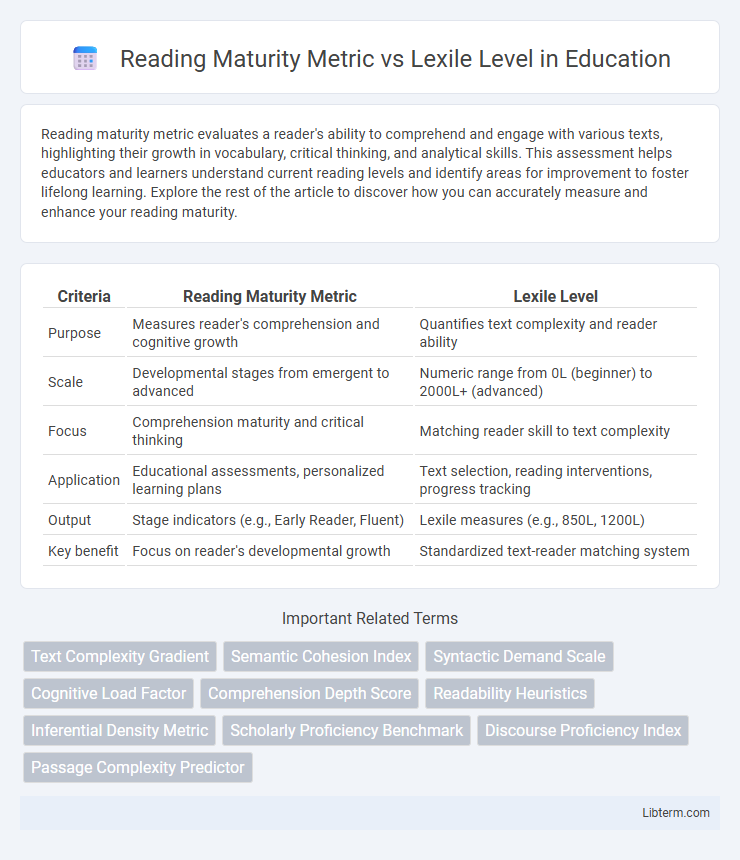Reading maturity metric evaluates a reader's ability to comprehend and engage with various texts, highlighting their growth in vocabulary, critical thinking, and analytical skills. This assessment helps educators and learners understand current reading levels and identify areas for improvement to foster lifelong learning. Explore the rest of the article to discover how you can accurately measure and enhance your reading maturity.
Table of Comparison
| Criteria | Reading Maturity Metric | Lexile Level |
|---|---|---|
| Purpose | Measures reader's comprehension and cognitive growth | Quantifies text complexity and reader ability |
| Scale | Developmental stages from emergent to advanced | Numeric range from 0L (beginner) to 2000L+ (advanced) |
| Focus | Comprehension maturity and critical thinking | Matching reader skill to text complexity |
| Application | Educational assessments, personalized learning plans | Text selection, reading interventions, progress tracking |
| Output | Stage indicators (e.g., Early Reader, Fluent) | Lexile measures (e.g., 850L, 1200L) |
| Key benefit | Focus on reader's developmental growth | Standardized text-reader matching system |
Understanding Reading Maturity Metric
Reading Maturity Metric evaluates a reader's comprehension skills by analyzing their ability to interpret complex texts and grasp nuanced meanings beyond basic word recognition. Unlike Lexile Level, which quantifies reading difficulty based on sentence length and word frequency, Reading Maturity Metric emphasizes cognitive engagement and critical thinking in reading. This metric provides educators with deeper insights into a student's readiness to handle advanced literary concepts and develop higher-order comprehension strategies.
What Is the Lexile Level?
The Lexile Level is a standardized measurement that quantifies a reader's ability and the complexity of texts on the same scale, ranging from below 200L for beginning readers to above 1600L for advanced ones. It is widely used in educational settings to match students with reading materials that optimize comprehension and promote reading growth. Unlike the Reading Maturity Metric, which assesses overall reading development, the Lexile Level specifically evaluates text difficulty and reader proficiency based on sentence length and word frequency.
Key Differences Between RMM and Lexile
The Reading Maturity Metric (RMM) measures a reader's comprehension and critical thinking skills beyond decoding, emphasizing text complexity and cognitive engagement, whereas the Lexile Level primarily quantifies text difficulty based on vocabulary and sentence length. RMM integrates qualitative aspects such as inferencing and analytical ability, providing insights into reading maturity, while Lexile offers a quantitative scale designed for matching readers to text difficulty. These key differences make RMM more focused on evaluating advanced literacy skills, contrasting with Lexile's primary role in leveling reading materials for appropriate student placement.
Measuring Comprehension: RMM vs. Lexile
Reading Maturity Metric (RMM) assesses comprehension by evaluating a reader's ability to understand complex texts through in-depth analysis of vocabulary, syntax, and conceptual depth, rather than just decoding skills. Lexile Level primarily measures reading ability based on word recognition and sentence length, which correlates with text difficulty but does not directly assess comprehension outcomes. RMM provides a more nuanced measure of a reader's comprehension maturity by integrating semantic understanding and critical thinking skills beyond the surface-level metrics captured by Lexile.
Applications in Education
Reading Maturity Metric and Lexile Level serve distinct roles in educational settings; the Reading Maturity Metric evaluates students' comprehension growth over time, providing insights into their development stages, while Lexile Level measures the complexity of texts suitable for a reader's ability. Educators utilize Reading Maturity Metrics to tailor instruction that promotes progressive cognitive engagement, whereas Lexile Levels guide the selection of reading materials that match individual student proficiency. Combining these metrics enables personalized learning strategies, enhances reading interventions, and supports data-driven decisions in curriculum design.
Accuracy and Limitations
The Reading Maturity Metric measures comprehension growth and reading proficiency beyond basic decoding skills, emphasizing cognitive development in literacy. Lexile Level quantifies text complexity and reader ability mainly based on semantic and syntactic features but may not fully capture comprehension nuances or critical thinking. Both tools provide valuable insights but have limitations in predicting overall reading maturity, as they do not assess motivation, background knowledge, or engagement.
How RMM and Lexile Impact Curriculum Choices
Reading Maturity Metric (RMM) offers detailed insights into a student's comprehension maturity, guiding educators to tailor curriculum complexity effectively. Lexile Level quantifies text difficulty based on vocabulary and sentence length, enabling precise alignment of reading materials to individual student abilities. Integrating RMM with Lexile measurements helps optimize curriculum selections, ensuring balanced development of critical thinking and reading skills across diverse learner profiles.
Choosing the Right Metric for Students
Selecting the appropriate metric between Reading Maturity Metric and Lexile Level depends on the student's reading development and instructional goals. Reading Maturity Metric evaluates comprehension skills and reading stamina, offering insight into a student's readiness for complex texts. Lexile Level measures text complexity based on word frequency and sentence length, aiding educators in matching students to suitable reading materials for skill improvement.
Integrating RMM and Lexile in Assessment
Integrating Reading Maturity Metric (RMM) with Lexile Level enhances assessment accuracy by combining comprehension depth and text complexity measures. RMM evaluates a reader's cognitive engagement and critical thinking skills, while the Lexile Level quantifies text difficulty, creating a comprehensive profile of reading ability. This integrated approach supports tailored instruction and targeted interventions, optimizing literacy development outcomes.
Future Trends in Reading Measurement
Emerging technologies in educational assessment are shifting the focus from traditional Lexile levels toward more holistic Reading Maturity Metrics that evaluate comprehension, critical thinking, and adaptive learning capabilities. Advanced data analytics and AI-driven platforms enable personalized reading profiles, capturing nuanced progress beyond simple text difficulty scores. Future trends emphasize integrating cognitive and affective factors to create dynamic, real-time reading assessments tailored to individual growth trajectories.
Reading Maturity Metric Infographic

 libterm.com
libterm.com